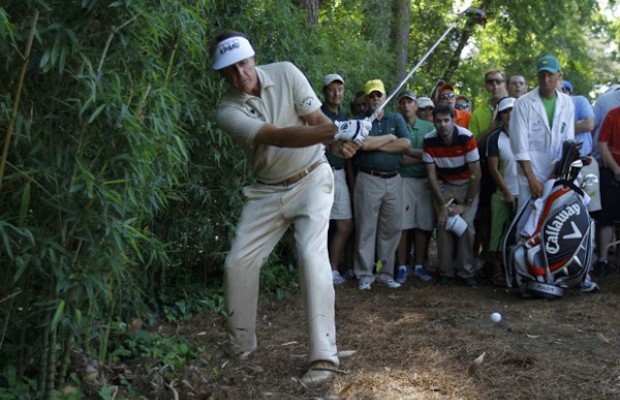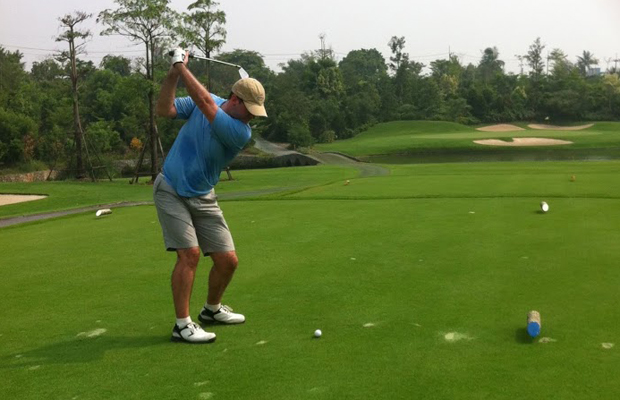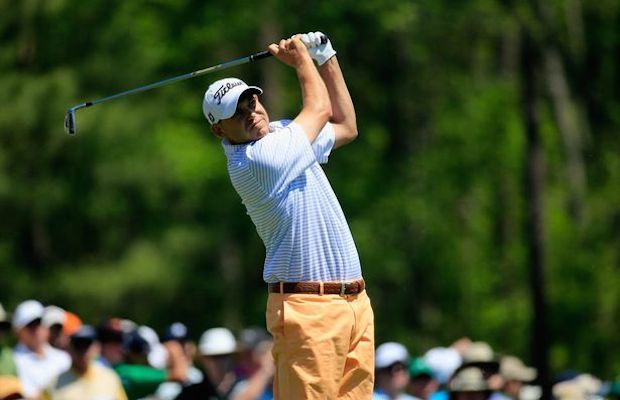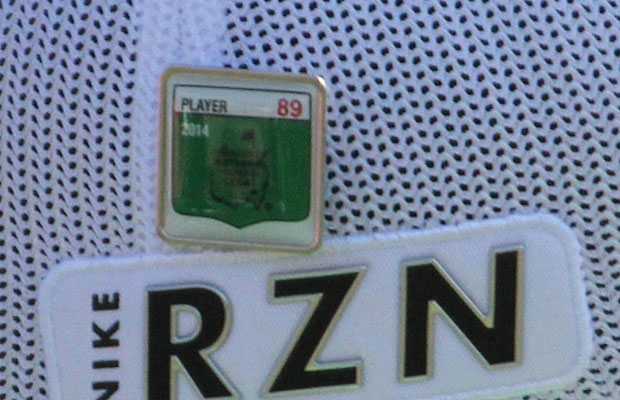Opinion & Analysis
Hole-By-Hole: The Best and Worst Shots in Masters History (Front 9)

Everyone has their favorite moments from the Masters. But what are the best and worst shots in Masters history for each hole at Augusta National?
From shots that directly impacted the outcome of the tournament, to others that were impossibly shocking, miserable, or symbolic in their own right, every hole has a story to tell.
77 years, over 3,000 different players, and more than 1 million shots taken. These are the legendary bests and worsts forever etched in Masters lore.
Related: Hole-By-Hole: The Best And Worst Shots In Masters History (Back 9)
No. 1: Tea Olive — Par 4, 445 yards
The Best
It wasn’t a particularly long drive. It didn’t set up a scoring opportunity. But 39-years ago Lee Elder became the first black man to play in the Masters, and his opening drive on Tea Olive ripped through the color barrier at Augusta National once and for all.
By the late 1960s, Congress was troubled that no African-American had ever played in the Masters. And in 1973 they called for Augusta co-founder Clifford Roberts to extend a special invitation to Elder. The soft-spoken Elder would have none of it.
“I don’t want anything special,” Elder said. “I will make it on my own.”
And he did.
Elder qualified for the 39th Masters by winning the Monsanto Open. Though he’d miss the cut that year, Elder went on to play in six other Masters. But more importantly, Elder’s tee shot in 1975 paved the way for the likes of Calvin Peete, Jim Thorpe and Tiger Woods, and created a legacy that would make the game better for us all.
The Worst
“Slammin Sammy” Snead’s beautiful, yet powerful swing is considered by many to be the sweetest in the history of the game. But at the 25th Masters in 1961, Snead’s opening drive created a scene that almost gave new meaning to his moniker.
Snead didn’t give the group ahead of him time to clear the landing area, and his drive nearly shaved the whiskers off fellow competitor, Tommy Bolt. Bolt, known on Tour as “Terrible Tommy,” gave Snead a searing tongue-lashing and even considered “slammin” Sammy before cooler heads prevailed.
Bolt’s tirade wasn’t as frightening as say, Mike Tyson’s “I want to eat your babies” rant towards Lennox Lewis. And fisticuffs were ultimately avoided. But Snead’s psyche was rattled. The normally unflappable Snead missed a two-foot putt for par and went on to finish nine shots off the lead.
No. 2: Pink Dogwood — Par 5, 575 yards
The Best
Louis Oosthuizen doesn’t have a green jacket like 1935 Masters champion Gene Sarazen. But thanks to a preposterous double-eagle during the final round of the 2012 Masters, he does have a place in the “Albatross Club” alongside Sarazen.
Oosthuizen’s albatross was straight out of an EA Sports PGA Tour video game. Four-iron, 256 yards, ball hits short of the green, ball bounces favorably onto the green, ball catches the perfect slope, ball feeds some 90-feet towards the hole, ball drops gently over the front lip.
It was the fourth double-eagle in Masters history — the first ever on Pink Dogwood — and it gave Oosthuizen the outright lead. But when Bubba Watson’s slapstick hook-shot on the second playoff hole secured the 76th Masters championship, any thoughts of an “Oosthuizen Bridge” were laid to rest.
The Worst
David Duval tore up Augusta National during his practice rounds leading up to the 70th Masters in 2006. But after he duck-hooked his drive on No. 2 deep in the pines, you had to wonder if Duval himself wanted to duck under the ropes and just skip town.
Looking more like a weekend hacker than the former No. 1 player in the world, Duval needed six shots, including two penalty strokes just to reach the greenside bunker. By the time it was over, the result was a second-round, quintuple-bogey 10, the highest score ever on Pink Dogwood.
To his credit Duval turned back the clock with four birdies over a six-hole stretch later in the round. But the gallant effort was too little, too late. Duval finished his tournament 15-over par in one of the most bipolar days Augusta National has ever seen. And Duval remained an enigma, wrapped in a paradox, shrouded in Augusta pine.
No. 3: Flowering Peach — Par 4, 350 yards
The Best
Historically “Flowering Peach” has been more like a sour lemon when it comes to eagles surrendered. But in 2011, Charl Schwartzel became the only player in Masters history to eagle No. 3 en route to victory.
Schwartzel’s hole-out wedge from 114-yards set the tone for what followed. Schwartzel recorded the lowest final-round score of any Masters champion in two decades, and also became the first Masters champion to birdie the last-four holes on the final day.
The 75th Masters featured a Tiger Woods charge, a Rory McIlroy collapse and challenges by Jason Day and Adam Scott. But on this chaotic afternoon at Augusta, “Flowering Peach” was only sweet for Schwartzel.
The Worst
It’s usually a good idea to “get something off your chest.” For Jeff Maggert in 2003, it wasn’t. Maggert felt the sting of golf’s cruel side when his second shot on No. 3 clipped the front lip of a fairway bunker, backfired off his chest, and fell back tauntingly almost to the same spot he’d just hit from.
After a two-stroke penalty was assessed, Maggert’s next shot flew over the green, followed by another shot that ran 18-feet past the hole. And just that quickly, Maggert and his 54-hole lead was done. Maggert was inconsolable after his triple-bogey seven on “Flowering Peach.” It was probably the main reason he didn’t become the 67th Masters champion.
“I’d like to play that hole over again,” Maggert said afterwards. “I know that much.”
Golf, cruel? Really?
No. 4: Flowering Crabapple — Par 3, 240 yards
The Best
Jeff Sluman is a jockey-size 5-foot 7-inches, 141 pounds, and has always been one of the smallest players on Tour. But in 1992 Sluman hit one of the biggest shots in Masters history, and became the only player to ever record a hole-in-one on Augusta’s formidable fourth hole.
In the first round of the 56th Masters, Sluman grabbed a 4-iron and struck his ball into swirling winds deceptive enough to complicate club selection.
“It looked pretty good when it left the club,” Sluman said. “But you never dreamed it was going in.”
Sluman’s ball landed 20-feet short of the hole, slowly crawled uphill and barely fell into the cup. After Sluman’s ace, a fan in the crowd yelled out asking for the ball, and the good-natured Sluman obliged, tossing it into the gallery. The fan was his mom.
The Worst
You know the expression “you have to see it to believe it?” That probably sums up the bizarre sequence of shots Phil Mickelson hit on the fourth hole of the 76th Masters in 2012. After Mickelson’s tee shot clanked off the grandstand and into Augusta’s wooded foliage, it went beyond “Phil being Phil.” It went “Lefty being Righty.”
Mickelson turned his wedge upside-down and played right-handed. On his first attempt, the ball dribbled out about a foot. Mickelson nearly axed himself in the leg on an awkward second attempt. And his third attempt landed in the same greenside bunker Mickelson was aiming for in the first place off the tee.
Mickelson’s bunker shot nearly dropped in, but the eventual triple-bogey six doomed any chance Mickelson had to win his fourth green jacket. Mickelson fell from one shot off the lead to five shots back. That goes to show no matter who you are or how well things are going, anything can happen at Augusta National.
No. 5: Magnolia — Par 4, 445 yards
The Best
Jack Nicklaus owns nearly every significant Masters record there is. Most wins, most runner-ups and most top-5 finishes all belong to Jack. And in 1995, Nicklaus became the only player in Masters history to eagle the same hole, twice, in the same tournament.
Eagle No. 1 came during the first round of the 59th Masters from 185 yards out. Nicklaus grabbed his 5-iron, fired at the pin and his ball found the hole on the fly. Prior to that, Nicklaus hadn’t eagled “Magnolia” in 36 previous Masters appearances. But Nicklaus wasn’t done yet.
Lightning struck twice for Nicklaus in the third round when he pulled a 7-iron from 165 yards for his second eagle of the round. Nicklaus admitted afterwards he aimed for the middle of the green because of a difficult pin position, but his ball landed a few feet from the hole instead and rolled in. It’s good to be Jack.
The Worst
Practice? What are we talking about, practice? Before there was Allen Iverson, there was Dow Finsterwald. And yes, Finsterwald was talking about practice. Because sometimes practice makes perfect. But other times it destroys your chance to become a Masters champion.
In the opening round of the 24th Masters in 1960, Finsterwald made a routine par on “Magnolia.” He pulled his ball from the cup, dropped it back on the putting surface and hit it off the green in the direction of the sixth tee. It was the worst shot Finsterwald never had to take.
The next day Finsterwald was assessed a retroactive two-stroke penalty for what was deemed an illegal practice stroke. Finsterwald wasn’t disqualified since his practice stroke didn’t occur with the ball in play. But he finished one shot behind eventual winner Arnold Palmer, costing him the opportunity to play Palmer in an 18-hole playoff.
No. 6: Juniper — Par 3, 180 yards
The Best
The Open Championship hadn’t been played in three years, the U.S. Open was cancelled and the PGA Championship was postponed. The world was at war and a hero was needed. In a 1942 playoff at the ninth Masters, Byron Nelson obliged.
Nelson was visibly pale and exhausted, suffering from a severe stomach virus before the playoff began. Ben Hogan offered to postpone the playoff, but Nelson refused. Down three shots to Hogan to start No. 6, Nelson stuffed an iron close to the pin for birdie, setting off a stretch of golf that can only be called “cruel in perfection.”
Nelson went 6-under par over the next eight holes to hold off Hogan by one shot. Hogan called it the best stretch of golf he’d ever seen. Nelson’s “never give up” mentality gave the country something to rally around, and made Nelson one of the greatest Masters champions of all-time.
The Worst
Jose Maria Olazabal was one-shot off the lead in the second round of the 1991 Masters when his tee shot fell short of the green on No. 6. It seemed harmless enough until Olazabal needed four more shots just to get his ball on the putting surface.
The green on “Juniper” is sloped downward to such degree, that players over the years have joked “an elephant must be buried beneath it.”
Olazabal’s first chip rolled back to his feet. His second shot was a carbon copy. Even his third shot rolled off the back edge. Olazabal took a quadruple-bogey seven for the hole. And his safari on No. 6 played a key role in finishing one stroke behind the 55th Masters champion Ian Woosnam.
No. 7: Pampas — Par 4, 450 yards
The Best
After Byron Nelson won the fourth Masters Tournament in 1937, the shot that had everyone talking was his opening tee shot on No. 7. He drove the green. Nelson went on to win a second green jacket a few years later, but he’d never again reach the green in one at “Pampas.”
The birdie on No. 7 certainly contributed to Nelson’s championship, but just as importantly it highlighted the fact that something had to be done about the pint-sized, drive and pitch par-4 that only measured 340 yards.
A few years later, “Pampas” was lengthened to 365 yards. And changes in 2002 and 2006 brought No. 7 to its current 450 yards. Nelson is often credited for being “The Father of the Modern Golf Swing.” But he also might be credited for being the father of present-day 7th hole at Augusta National.
The Worst
Charles Coody had the reputation for being one of most disciplined players on Tour, and was the last player you’d expect to come unglued. But in the first round of the 36th Masters in 1972, that’s exactly what happened to the defending champion.
Coody just recorded an ace on No. 6, so he should have been relaxed. But Coody sprayed his drive right, then hooked his approach left. And hitting out of the greenside bunker turned into an episode of the “Twilight Zone.”
Coody nearly whiffed at his first attempt. He barely moved the ball on his second attempt. And Coody’s third attempt unbelievably also stayed in the sand. Coody needed a fourth bunker shot to get up and down for the highest score ever recorded on No. 7, a triple-bogey seven.
No. 8: Yellow Jasmine — Par 5, 570 yards
The Best
Bruce Devlin never won a Masters championship. But in the first round of the 31st Masters in 1967, he became only the second player to record a double-eagle in Masters history.
Devlin was dealing with painful blisters on both his feet that afternoon, and never really played himself into contention. Devlin would later say it was the only good shot he hit all day. A 4-wood, 248 yards out, that hit the front of the green and tracked into the hole.
When Gene Sarazen was told of Devlin’s double-eagle, he said Devlin’s shot was harder than his own in 1935, because Devlin couldn’t even see the target he was shooting for. For the record, Devlin’s was also 13 yards longer.
The Worst
Augusta National sinks its teeth into every player eventually: even the Masters foremost champion, Jack Nicklaus. Nicklaus recorded his first triple-bogey during the second round of the 34th Masters in 1970.
Nicklaus was just three shots off the lead at the time, and had a clean look at getting on in two, but uncharacteristically hooked his approach shot into the woods short of the green. Making matters worse, Nicklaus couldn’t find his ball, forcing him to take a stroke and distance penalty.
Obviously frustrated by the turn of events, Nicklaus played his shot over, coming up short of the green again, and three-putted for a triple-bogey eight. Nicklaus played well enough over the final 46 holes to finish in the top-10, but his fourth green jacket would have to wait.
No. 9: Carolina Cherry — Par 4, 460 yards
The Best
What do you do if you’re playing the final round of a major in a tournament no one gives you any chance of winning, and you’re facing what can only be described as a must-make putt to keep any hope of winning alive? If you’re 46-year old Jack Nicklaus in 1986 at the 50th Masters, you crack a joke.
Jack Nicklaus stepped away from his 12-foot birdie opportunity on “Carolina Cherry” when he heard the crowd on No. 8 erupt for Tom Kite’s eagle pitch-in. Nicklaus stepped away again when a second roar broke out from No. 8, this time for Seve Ballesteros’ eagle chip-in.
Before Nicklaus finally addressed his putt, he turned to the gallery nearest him and said, “Let’s see if we can make that same kind of noise here.” Nicklaus’ putt hit the hole dead center, and set the tone for a back-nine charge that would bring Nicklaus the loudest canon fire roar of all: the roar of winning his sixth green jacket and 18th career major.
The Worst
Lanny Wadkins has always been supremely confident in his abilities on the golf course. But there’s a fine line between confidence and carelessness, and Wadkins crossed that line during the second round of the 55th Masters in 1991 when he missed the shortest putt in Masters history.
Wadkins had just missed a four-foot putt for par on “Carolina Cherry” and was left with a tap-in. Not a pressure putt, not a knee-knocker, but a gimme just inches from the cup. So naturally Wadkins decided to putt… backhanded.
Wadkins completely missed the cup, of course. And adding insult to injury, his ball rolled four feet past the hole, leaving him with the exact same putt he had for par just moments earlier.
Opinion & Analysis
The 2 primary challenges golf equipment companies face

As the editor-in-chief of this website and an observer of the GolfWRX forums and other online golf equipment discourse for over a decade, I’m pretty well attuned to the grunts and grumbles of a significant portion of the golf equipment purchasing spectrum. And before you accuse me of lording above all in some digital ivory tower, I’d like to offer that I worked at golf courses (public and private) for years prior to picking up my pen, so I’m well-versed in the non-degenerate golf equipment consumers out there. I touched (green)grass (retail)!
Complaints about the ills of and related to the OEMs usually follow some version of: Product cycles are too short for real innovation, tour equipment isn’t the same as retail (which is largely not true, by the way), too much is invested in marketing and not enough in R&D, top staffer X hasn’t even put the new driver in play, so it’s obviously not superior to the previous generation, prices are too high, and on and on.
Without digging into the merits of any of these claims, which I believe are mostly red herrings, I’d like to bring into view of our rangefinder what I believe to be the two primary difficulties golf equipment companies face.
One: As Terry Koehler, back when he was the CEO of Ben Hogan, told me at the time of the Ft Worth irons launch, if you can’t regularly hit the golf ball in a coin-sized area in the middle of the face, there’s not a ton that iron technology can do for you. Now, this is less true now with respect to irons than when he said it, and is less and less true by degrees as the clubs get larger (utilities, fairways, hybrids, drivers), but there remains a great deal of golf equipment truth in that statement. Think about it — which is to say, in TL;DR fashion, get lessons from a qualified instructor who will teach you about the fundamentals of repeatable impact and how the golf swing works, not just offer band-aid fixes. If you can’t repeatably deliver the golf club to the golf ball in something resembling the manner it was designed for, how can you expect to be getting the most out of the club — put another way, the maximum value from your investment?
Similarly, game improvement equipment can only improve your game if you game it. In other words, get fit for the clubs you ought to be playing rather than filling the bag with the ones you wish you could hit or used to be able to hit. Of course, don’t do this if you don’t care about performance and just want to hit a forged blade while playing off an 18 handicap. That’s absolutely fine. There were plenty of members in clubs back in the day playing Hogan Apex or Mizuno MP-32 irons who had no business doing so from a ballstriking standpoint, but they enjoyed their look, feel, and complementary qualities to their Gatsby hats and cashmere sweaters. Do what brings you a measure of joy in this maddening game.
Now, the second issue. This is not a plea for non-conforming equipment; rather, it is a statement of fact. USGA/R&A limits on every facet of golf equipment are detrimental to golf equipment manufacturers. Sure, you know this, but do you think about it as it applies to almost every element of equipment? A 500cc driver would be inherently more forgiving than a 460cc, as one with a COR measurement in excess of 0.83. 50-inch shafts. Box grooves. And on and on.
Would fewer regulations be objectively bad for the game? Would this erode its soul? Fortunately, that’s beside the point of this exercise, which is merely to point out the facts. The fact, in this case, is that equipment restrictions and regulations are the slaughterbench of an abundance of innovation in the golf equipment space. Is this for the best? Well, now I’ve asked the question twice and might as well give a partial response, I guess my answer to that would be, “It depends on what type of golf you’re playing and who you’re playing it with.”
For my part, I don’t mind embarrassing myself with vintage blades and persimmons chasing after the quasi-spiritual elevation of a well-struck shot, but that’s just me. Plenty of folks don’t give a damn if their grooves are conforming. Plenty of folks think the folks in Liberty Corner ought to add a prison to the museum for such offences. And those are just a few of the considerations for the amateur game — which doesn’t get inside the gallery ropes of the pro game…
Different strokes in the game of golf, in my humble opinion.
Anyway, I believe equipment company engineers are genuinely trying to build better equipment year over year. The marketing departments are trying to find ways to make this equipment appeal to the broadest segment of the golf market possible. All of this against (1) the backdrop of — at least for now — firm product cycles. And golfers who, with their ~15 average handicap (men), for the most part, are not striping the golf ball like Tiger in his prime and seem to have less and less time year over year to practice and improve. (2) Regulations that massively restrict what they’re able to do…
That’s the landscape as I see it and the real headwinds for golf equipment companies. No doubt, there’s more I haven’t considered, but I think the previous is a better — and better faith — point of departure when formulating any serious commentary on the golf equipment world than some of the more cynical and conspiratorial takes I hear.
Agree? Disagree? Think I’m worthy of an Adam Hadwin-esque security guard tackle? Let me know in the comments.
@golfoncbs The infamous Adam Hadwin tackle ? #golf #fyp #canada #pgatour #adamhadwin ? Ghibli-style nostalgic waltz – MaSssuguMusic
Podcasts
Fore Love of Golf: Introducing a new club concept

Episode #16 brings us Cliff McKinney. Cliff is the founder of Old Charlie Golf Club, a new club, and concept, to be built in the Florida panhandle. The model is quite interesting and aims to make great, private golf more affordable. We hope you enjoy the show!
Opinion & Analysis
On Scottie Scheffler wondering ‘What’s the point of winning?’

Last week, I came across a reel from BBC Sport on Instagram featuring Scottie Scheffler speaking to the media ahead of The Open at Royal Portrush. In it, he shared that he often wonders what the point is of wanting to win tournaments so badly — especially when he knows, deep down, that it doesn’t lead to a truly fulfilling life.
View this post on Instagram
“Is it great to be able to win tournaments and to accomplish the things I have in the game of golf? Yeah, it brings tears to my eyes just to think about it because I’ve literally worked my entire life to be good at this sport,” Scheffler said. “To have that kind of sense of accomplishment, I think, is a pretty cool feeling. To get to live out your dreams is very special, but at the end of the day, I’m not out here to inspire the next generation of golfers. I’m not out here to inspire someone to be the best player in the world, because what’s the point?”
Ironically — or perhaps perfectly — he went on to win the claret jug.
That question — what’s the point of winning? — cuts straight to the heart of the human journey.
As someone who’s spent over two decades in the trenches of professional golf, and in deep study of the mental, emotional, and spiritual dimensions of the game, I see Scottie’s inner conflict as a sign of soul evolution in motion.
I came to golf late. I wasn’t a junior standout or college All-American. At 27, I left a steady corporate job to see if I could be on the PGA Tour starting as a 14-handicap, average-length hitter. Over the years, my journey has been defined less by trophies and more by the relentless effort to navigate the deeply inequitable and gated system of professional golf — an effort that ultimately turned inward and helped me evolve as both a golfer and a person.
One perspective that helped me make sense of this inner dissonance around competition and our culture’s tendency to overvalue winning is the idea of soul evolution.
The University of Virginia’s Division of Perceptual Studies has done extensive research on reincarnation, and Netflix’s Surviving Death (Episode 6) explores the topic, too. Whether you take it literally or metaphorically, the idea that we’re on a long arc of growth — from beginner to sage elder — offers a profound perspective.
If you accept the premise literally, then terms like “young soul” and “old soul” start to hold meaning. However, even if we set the word “soul” aside, it’s easy to see that different levels of life experience produce different worldviews.
Newer souls — or people in earlier stages of their development — may be curious and kind but still lack discernment or depth. There is a naivety, and they don’t yet question as deeply, tending to see things in black and white, partly because certainty feels safer than confronting the unknown.
As we gain more experience, we begin to experiment. We test limits. We chase extreme external goals — sometimes at the expense of health, relationships, or inner peace — still operating from hunger, ambition, and the fragility of the ego.
It’s a necessary stage, but often a turbulent and unfulfilling one.
David Duval fell off the map after reaching World No. 1. Bubba Watson had his own “Is this it?” moment with his caddie, Ted Scott, after winning the Masters.
In Aaron Rodgers: Enigma, reflecting on his 2011 Super Bowl win, Rodgers said:
“Now I’ve accomplished the only thing that I really, really wanted to do in my life. Now what? I was like, ‘Did I aim at the wrong thing? Did I spend too much time thinking about stuff that ultimately doesn’t give you true happiness?’”
Jim Carrey once said, “I think everybody should get rich and famous and do everything they ever dreamed of so they can see that it’s not the answer.”
Eventually, though, something shifts.
We begin to see in shades of gray. Winning, dominating, accumulating—these pursuits lose their shine. The rewards feel more fleeting. Living in a constant state of fight-or-flight makes us feel alive, yes, but not happy and joyful.
Compassion begins to replace ambition. Love, presence, and gratitude become more fulfilling than status, profits, or trophies. We crave balance over burnout. Collaboration over competition. Meaning over metrics.
Interestingly, if we zoom out, we can apply this same model to nations and cultures. Countries, like people, have a collective “soul stage” made up of the individuals within them.
Take the United States, for example. I’d place it as a mid-level soul: highly competitive and deeply driven, but still learning emotional maturity. Still uncomfortable with nuance. Still believing that more is always better. Despite its global wins, the U.S. currently ranks just 23rd in happiness (as of 2025). You might liken it to a gifted teenager—bold, eager, and ambitious, but angsty and still figuring out how to live well and in balance. As much as a parent wants to protect their child, sometimes the child has to make their own mistakes to truly grow.
So when Scottie Scheffler wonders what the point of winning is, I don’t see someone losing strength.
I see someone evolving.
He’s beginning to look beyond the leaderboard. Beyond metrics of success that carry a lower vibration. And yet, in a poetic twist, Scheffler did go on to win The Open. But that only reinforces the point: even at the pinnacle, the question remains. And if more of us in the golf and sports world — and in U.S. culture at large — started asking similar questions, we might discover that the more meaningful trophy isn’t about accumulating or beating others at all costs.
It’s about awakening and evolving to something more than winning could ever promise.



























Pete McGill
Dec 16, 2018 at 3:22 am
I remember Watkins’ putt like it was yesterday. Yikes!
Lawrence Williams
Apr 15, 2014 at 2:11 pm
Well done my man, well done!
DavidI
Apr 9, 2014 at 8:51 am
Great read, really nicely written!
cheeks
Apr 8, 2014 at 5:53 pm
Fantastic piece, thank you Pete! Really enjoyed this, looking forward to the Back 9.
Floor-is
Apr 8, 2014 at 5:19 pm
What the hell is a double eagle? You’re a golf website guys, stop making up (stupid) names for things we already have names for. Was it an albatross? Yes it was!
Pete
Apr 8, 2014 at 8:01 pm
Floor, the Masters Tournament calls it a double-eagle, so the company’s pretty good. I’d have agreed with you though if I called it a triple-ace.
Ian
Apr 9, 2014 at 5:32 am
Eagle is two under par isn’t it (On a par 4 or 5)? So a double eagle would be double two under par.
Ian
Apr 9, 2014 at 5:45 am
And while we’re recognizing larger birds for fewer strokes (on par 4’s and 5’s)., I’d officilly like to petition the PGA of America to consider naming a hole in one (again on a par 4 or 5) a Dodo or an Ostrich…
Peakatron
Apr 9, 2014 at 9:33 am
An ace on a par five or a two on a par six is called a Condor.
http://en.wikipedia.org/wiki/Par_%28score%29
Pete
Apr 11, 2014 at 6:17 pm
Sarazen used a DoDo for his double-eagle, just sayin.
Floor-is
Apr 10, 2014 at 3:24 am
And that’s exactly what is the problem! A double eagle isn’t two times an eagle (2x two under for the hole) it’s an eagle plus a birdie (3 under for a single hole). So in that logic it would be called one-and-a-half eagle. Let’s just keep calling it an Albatross.
I’ve shot one, once by the way.
Martin
Apr 8, 2014 at 3:33 pm
Great article.
Keith
Apr 8, 2014 at 2:58 pm
I’m not sure where the +19 par for Duval is coming from. He was +15 (84,75) to miss the cut that year. He actually doubled #1 on Fri right before he made the 10 on #2, so he was +7 after two holes and came back to shoot 75.
Pete
Apr 8, 2014 at 8:06 pm
Nice catch Keith. Duval was 19-over after the debacle on No.2, and that six-hole stretch later in the round got him to 15-over.
jabrch
Apr 8, 2014 at 2:43 pm
Great article Pete!!!! Awesome read!